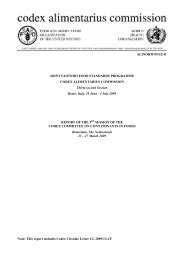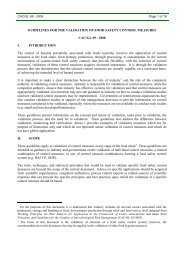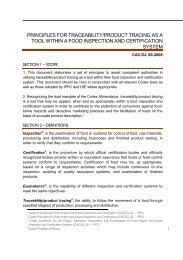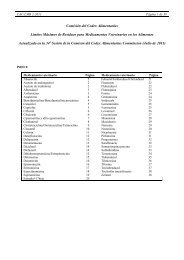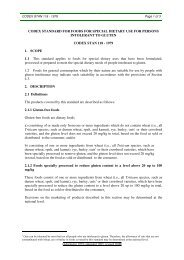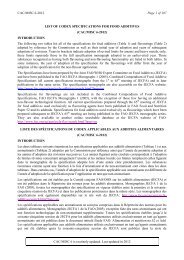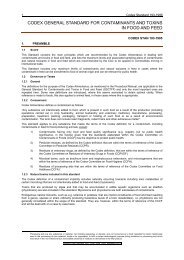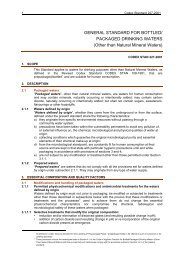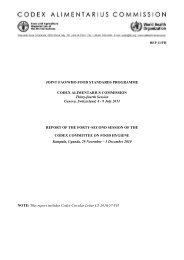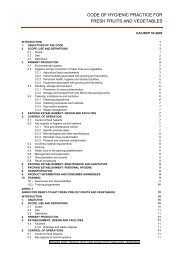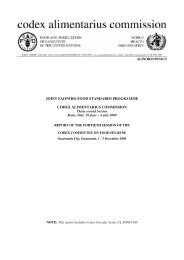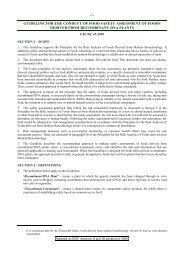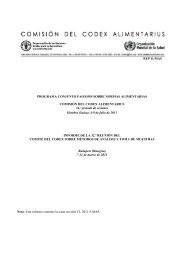General Standard for Food Additives - CODEX Alimentarius
General Standard for Food Additives - CODEX Alimentarius
General Standard for Food Additives - CODEX Alimentarius
Create successful ePaper yourself
Turn your PDF publications into a flip-book with our unique Google optimized e-Paper software.
<strong>CODEX</strong> STAN 192-1995<br />
Table One<br />
Note 101 Use level singly, not to exceed 15 000 mg/kg in combination.<br />
Note 102 For use in fat emulsions <strong>for</strong> baking purposes only.<br />
Note 103 Except <strong>for</strong> use in special white wines at 400 mg/kg.<br />
Note 104 Maximum 5 000 mg/kg residue in bread and yeast-leavened bakery products.<br />
Note 105 Except <strong>for</strong> use in dried gourd strips (Kampyo) at 5 000 mg/kg.<br />
Note 106 Except <strong>for</strong> use in Dijon mustard at 500 mg/kg.<br />
Note 107 Except <strong>for</strong> use of sodium ferrocyanide (INS 535) and potassium ferrocyanide (INS 536) in food-grade<br />
dendridic salt at 29 mg/kg as anhydrous sodium ferrocyanide.<br />
Note 108 For use on coffee beans only.<br />
Note 109 Use level reported as 25 lbs/1 000 gal x (0.45 kg/lb) x (1 gal/3.75 L) x (1 L/kg) x (10E6 mg/kg) = 3 000<br />
mg/kg<br />
Note 110 For use in frozen French fried potatoes only.<br />
Note 111 Excluding dried glucose syrup used in the manufacture of sugar confectionery at 150 mg/kg and<br />
glucose syrup used in the manufacture of sugar confectionery at 400 mg/kg.<br />
Note 112 For use in grated cheese only.<br />
Note 113 Use level reported as acesulfame potassium equivalents (the reported maximum level can be<br />
converted to an aspartame-acesulfame salt basis by dividing by 0.44). Combined use of aspartameacesulfame<br />
salt with individual acesulfame potassium or aspartame should not exceed the individual<br />
maximum levels <strong>for</strong> acesulfame potassium or aspartame (the reported maximum level can be<br />
converted to aspartame equivalents by dividing by 0.68).<br />
Note 114 Excluding cocoa powder.<br />
Note 115 For use in pineapple juice only.<br />
Note 116 For use in doughs only.<br />
Note 117 Except <strong>for</strong> use in loganiza (fresh, uncured sausage) at 1 000 mg/kg.<br />
Note 118 Except <strong>for</strong> use in tocino (fresh, cured sausage) at 1 000 mg/kg.<br />
Note 119 Use level reported as aspartame equivalents (the reported maximum level can be converted to an<br />
aspartame-acesulfame salt basis by dividing by 0.64). Combined use of aspartame-acesulfame salt<br />
with individual aspartame or acesulfame potassium should not exceed the individual maximum levels<br />
<strong>for</strong> aspartame or acesulfame potassium (the reported maximum level can be converted to<br />
acesulfame potassium equivalents by multiplying by 0.68).<br />
Note 120 Except <strong>for</strong> use in caviar at 2 500 mg/kg.<br />
Note 121 Excluding fermented fish products at 1 000 mg/kg.<br />
Note 122 Subject to national legislation of the importing country.<br />
Note 123 1 000 mg/kg <strong>for</strong> beverages with pH greater than 3.5.<br />
Note 124 Only <strong>for</strong> products containing less than 7% ethanol.<br />
Note 125 For use as a release agent <strong>for</strong> baking pans in a mixture with vegetable oil.<br />
Note 126 For releasing dough in dividing or baking only.<br />
Note 127 As served to the consumer.<br />
Note 128 INS 334 (tartaric acid) only.<br />
Note 129 For use as an acidity regulator in grape juice.<br />
Note 130 Singly or in combination: butylated hydroxyanisole (INS 320), butylated hydroxytoluene (INS 321),<br />
tertiary butylated hydroquinone (INS 319), and propyl gallate (INS 310).<br />
Note 131 As a result of use as a flavour carrier.<br />
Note 132 Except <strong>for</strong> use at 130 mg/kg (dried basis) in semi-frozen beverages.<br />
Note 133 Any combination of butylated hydroxyanisole (INS 320), butylated hydroxytoluene (INS 321), and<br />
propyl gallate (INS 310) at 200 mg/kg, provided that single use limits are not exceeded.<br />
Note 134 Except <strong>for</strong> use in cereal-based puddings at 500 mg/kg.<br />
Note 135 Except <strong>for</strong> use in dried apricots at 2000 mg/kg, bleached raisins at 1500 mg/kg, desiccated coconut<br />
at 200 mg/kg and coconut from which oil has been partially extracted at 50 mg/kg.<br />
Note 136 To prevent browning of certain light coloured vegetables.<br />
Note 137 Except <strong>for</strong> use in frozen avocado at 300 mg/kg.<br />
Note 138 For use in energy-reduced products only.<br />
Note 139 For use in mollusks, crustaceans, and echinoderms only.<br />
Note 140 Except <strong>for</strong> use in canned abalone (PAUA) at 1 000 mg/kg.<br />
Note 141 For use in white chocolate only.<br />
Note<br />
142 Excluding coffee and tea.<br />
174



